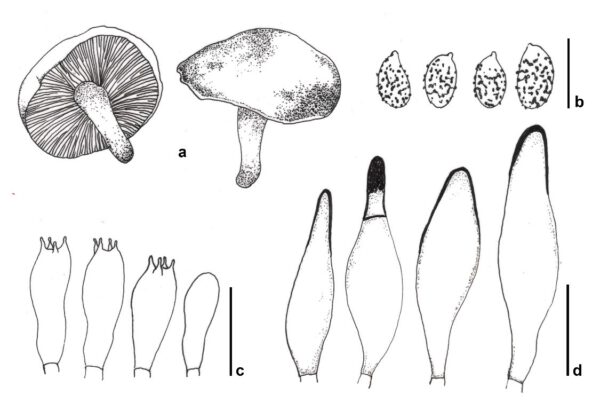Fungalpedia – Note 206, Melanoleuca
Melanoleuca Pat.
Citation if using this entry: Bera et al. 2024 (in prep) – Fungalpedia, Basidiomycota 1.
Index Fungorum, MycoBank, Facesoffungi, GenBank, Fig. 1
Classification: Incertae sedis, Agaricales, Agaricomycetes, Basidiomycota, Fungi
Melanoleuca was initially classified under the family Tricholomataceae R. Heim ex Pouzar (Pouzar 1983). Melanoleuca is characterized by a lack of distinctive features, with numerous species that exhibit macroscopic similarities, differing only in subtle characteristics such as colour, and odor of the basidiomata (Vizzini et al. 2011). It is well-known that morphological characteristics can be significantly impacted by environmental factors (Bon 1991, Boekhout 1999, Vizzini et al. 2011). However, the first infrageneric classification of Melanoleuca relied mostly on macromorphological features (Metrod 1942, 1948, Singer 1986, Kuhner 1978, Antonin et al. 2022). Bon (1978) first used a combination of both macro- and micromorphological characters for the classification of this genus (Antonin et al. 2022). Boekhout (1988) based on the cystidia presence and characters divided Melanoleuca into three subgenera: Melanoleuca subgen. Melanoleuca Pat., M. subgen. Urticocystis Boekhout, and M. subgen. Macrocystis Boekhout. The first molecular study on European species of this genus, was based on nrITS sequence data, revealing two distinct clades referring to the subgen. Urticocystis, including species with urticoid cystidia and subgen. Melanoleuca has species with macrocystidia (Vizzini et al. 2011). The systematic placement of this genus has been thoroughly investigated. In molecular studies (Matheny et al. 2006, Garnia et al. 2007), Melanoleuca was reclassified under Pluteaceae Kotl. & Pouzar. (Antonin et al. 2022).
He et al. (2019) transferred Melanoleuca to Incertae sedis, which is regarded as the current systematic position of the genus. The taxa under Melanoleuca are characterized by their typical tricholomatoid to collybioid basidiomata with umbonate, centrally depressed pileus (Kuhner 1978, Singer 1986, Boekhout 1988, 1999, Bon 1991, Watling & Turnbull 1998, Vizzini et al. 2011, Antonin et al. 2022). The lamellae have adnate to decurrent attachment with stipe (Antonin et al. 2022). Microscopically, the pileipellis is of either cutis or trichoderm type (Antonin et al. 2022). The presence of hymenial cystidia on both lamellar edges and faces depends on the species (Vizzini et al. 2011, Antonin et al. 2022). The ornamentations of the basidiospores show a positive amyloid reaction (Kuhner 1978, Singer 1986, Vizzini et al. 2011, Antonin et al. 2022). Clamp connections on hyphae are not present in Melanoleuca (Kuhner 1978, Singer 1986, Antonin et al. 2022). This genus is an edible saprotrophic mushroom that grows on grasslands, sand dunes, and forest floors (Boekhout 1988). The database of Mycobank (http://www.mycobank.org) recorded around 333 Melanoleuca species worldwide. However, with progressive phylogenetic analysis, many well-known species have been synonimized under one name (Kalmer et al. 2018). Currently, approximately 60 species of Melanoleuca have been reported (Wijayawardene et al. 2022).
Synonyms: Kinia Consiglio, Contu, Setti & Vizzini, Melaleuca Pat., Psammospora Fayod
Type species: Melanoleuca melaleuca (Pers.) Murrill (≡ Melaleuca vulgaris Pat., Agaricus melaleucus Pers., Gyrophila melaleuca (Pers.) Quél.)
Other accepted species: (Species Fungorum – search Melanoleuca)
Figure 1 – Melanoleuca strictipes (BRNM 781384). a Basidiomata. b Basidiospores. c Basidia. d Hymenial cystidia. Scale bars: b = 10 μm, c & d = 20 μm. Taken from Amandeep et al. (2015).
References
Metrod G. 1942 – Sur le genre Melanoleuca. Revue de Mycologie Supplementum, 7, 89–96.
Metrod G. 1948 – Essai sur le genre Melanoleuca Patouillard emend. Bulletin de la Societe mycologique de France, 64, 141–165.
Entry by
Ishika Bera, Center of Excellence in Fungal Research, Mae Fah Luang University, Chiang Rai 57100, Thailand
(Edited by Kevin D Hyde, Samaneh Chaharmiri-Dokhaharani, & Achala R. Rathnayaka)
Published online 15 February 2024
